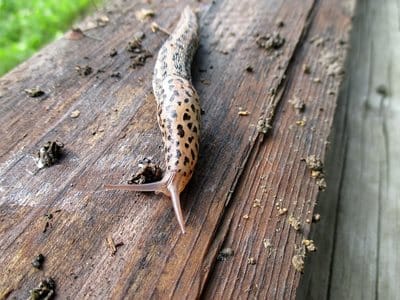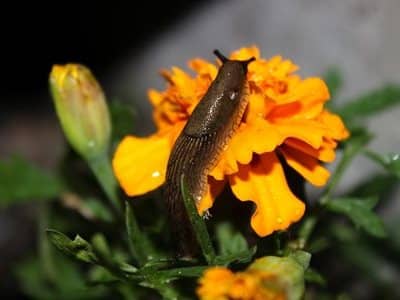Of all the creatures great and small that share your piece of outdoor heaven, slugs probably have the biggest image problem.
Not only do many of the slug species in the UK cause untold damage to ornamental plants and food crops alike, they are, frankly, not the most attractive of garden visitors. “Look how pretty the slugs look climbing up the side of the house,” said no one ever. Their relative the snail engenders a bit more fondness, even though they too can be destructive. This may be because they are less naked and therefore less unpleasant to pick up and inspired a Magic Roundabout character called Brian.
Both slugs and snails also harbour lungworm larvae which can be picked up from contact with the creatures themselves (mostly by eating them) or from the slime trail they use to get around your garden. While there are forms of lungworm that can infect and harm humans in other parts of the world, here in the UK it is our pet dogs and cats at risk from infestation and lungworm can prove fatal if untreated.
While some slugs are carnivorous and helpfully prey on smaller slug species, most are herbivores wherein lies the main conflict with gardeners. They are prevalent and surprisingly hardy creatures who pack a whole arsenal of survival mechanisms, so whatever is unleashed upon them, it is unlikely to eradicate the population – especially when it’s estimated the average garden can be home to as many as 20,000 slugs and snails. The gardener’s best strategy is to try and keep the slimy population under control and if this fails, consider re-planting the garden according to its own personal slug problem.
Not being able to wipe out the population might also be to the gardener’s advantage as some of the larger slug species will feast on decomposing organic matter such as dead leaves, animal droppings and even dead slugs and snails, so can help speed up the composting process; if only they would stay in the compost heap and away from the flower beds or veg patch.

Don’t forget, they are also a valuable food source for more welcome garden visitors such as hedgehogs, useful garden beetles and the song thrush.
While annihilation might be a losing game, gardeners are not for want of trying and it is estimated green fingered Brits use more than four billion slug pellets a year. Slug pellets are powerful poisons that like all chemical methods of pest control can pose a danger to pets, birds and other wildlife and even children. They do not discriminate between helpful slugs and those intent on destroying your plants and can even make the problem worse by stimulating slug reproduction.
There are more natural and harmless (not necessarily to the slug) methods of control. You can roughly put these into the following broad categories: Capture/Destroy, Repel/Contain and Accept (learning to live with, if not love exactly, your slug population).
Salt kills slugs. Honestly, it does it horribly and it is not pretty but salting a slug to death is not going to endanger anything else – apart from a few plants if you are too liberal with the salt application. It isn’t for the faint hearted (especially if you take a few minutes to learn how fascinating slugs really are). This only works with bold as brass, above ground slugs who leave helpful slime trails so you can track them down. It also doesn’t work when they are climbing up the side of your house.
You can set up slug and snail traps either with the intention of releasing them somewhere far away from anyone’s garden or destroying them en masse. Simply leaving them to perish in the trap will only attract more slugs and snails so you will have to decide in advance how you want to deal with your captives.
Underground dwelling slugs are a particular problem as you are unlikely to see the damage until it is too late to save the plant, plus the culprit is hard to find. One solution is to introduce nematodes into your garden, microscopic worms which are a natural enemy of slugs. They kill them so you don’t have to and have the advantage that they won’t harm children, pets or wildlife.
Slugs make their way around your garden in a unique way. They use their slime to enable them to traverse difficult terrain, including abrasive and sharp materials that in theory should be hazardous for something as soft bodied and seemingly vulnerable as a slug.
If you can somehow deal with the slime, then you are literally stopping the slug in its tracks. Absorbent materials help. Some people swear by a liberal portion of porridge oats around the areas you want to protect although these are likely to get eaten by other garden visitors (hopefully not the Three Bears) and will not serve the purpose once it rains. There are materials you can purchase and most garden centres will sell different kinds of slug barrier which make moving difficult or uncomfortable for them and discourage the slugs from entering protected areas of your garden.
Believe it or not, you can also use slug fences (think tiny, tiny deer fencing) to protect vulnerable plants. Keeping your soil dry or at least avoiding irrigating the ground in the evening/nightfall when slugs are most active will also make it less attractive to them.
Although we loathe them more than we will ever love them, slugs are a fact of gardening life. Some areas of the country are worse than others and some weather conditions either send the slug population through the roof or cause them to hunker down to survive a hot dry spell and leave your garden relatively untouched.
Some plants and varieties of produce are wildly attractive to slugs, others are mostly ignored. If you have a large slug population, it is possible to make your garden or veg patch less of a slug magnet with selective planting. Even food crops have varieties that are less attractive or at least more resistant to slug attack.

You can give your other plants a fighting chance by transplanting them when they are bigger and stronger. Some people will even grow a ‘sacrificial bed’ of slug delicacies to contain the pest within particular areas of the garden, hopefully somewhere well away from the part the gardener is trying to protect!
If you’d like to keep up to date with Rolawn advice, news and special offers by email, please sign up to our Newsletter or follow us on Facebook and Twitter.
Guest Author: Melanie Hannam
With an Honours Degree in Psychology from Durham University, and a qualification in journalism through the NCTJ, Mel draws on her knowledge of and experience in Journalism and Communications as well as her love of literature, travel and adventure to write on a range of subjects. Mel is an award-winning writer who specializes in health sector communications, but her primary passion is sled dogs and she often writes for canine-related publications and blogs.